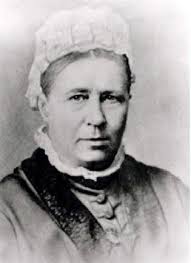Queer Places:
Red House Museum, 281 Oxford Rd, Gomersal, Cleckheaton BD19 4JP, UK
High
Royd, now Gomersal Lodge Hotel, 189 Spen Ln, Gomersal, Cleckheaton BD19 4PJ, UK
St. Mary The Blessed Virgin, Spen Ln, Gomersal, Goemrsal BD19 4LS, UK
 Mary Taylor
(26 February 1817 - 1 March 1893) and her younger sister Martha were sent
to a boarding school in Mirfield, a few miles from their home. In January
1831 Taylor met author Charlotte
Brontë and they became friends. They both left the school in 1832 and in
the next few years regularly visited each other at home. The radical & boisterous Taylor family of Red House were described as the 'Yorke' family in Charlotte Bronte's novel 'Shirley'. Charlotte described the family so well that Mary wrote "There is a strange feeling in reading it of hearing us all talking" (Mary Taylor to Charlotte Bronte 13 Aug 1850). Mary Taylor appears as 'Rose York'.
Mary Taylor
(26 February 1817 - 1 March 1893) and her younger sister Martha were sent
to a boarding school in Mirfield, a few miles from their home. In January
1831 Taylor met author Charlotte
Brontë and they became friends. They both left the school in 1832 and in
the next few years regularly visited each other at home. The radical & boisterous Taylor family of Red House were described as the 'Yorke' family in Charlotte Bronte's novel 'Shirley'. Charlotte described the family so well that Mary wrote "There is a strange feeling in reading it of hearing us all talking" (Mary Taylor to Charlotte Bronte 13 Aug 1850). Mary Taylor appears as 'Rose York'.
In 1840 Taylor's father died leaving debts. She considered immigrating to
New Zealand, believing that she would fare better in New Zealand. Her
younger brother William Waring Taylor arrived in Wellington in April 1842.
Mary Taylor spent some time in Belgium and Germany, studying and teaching.
On 18 March 1845 she left London on the ship Louisa Campbell and arrived at
Wellington on the 24th July.
Taylor settled in Wellington where she lived at first with her brother
William Waring Taylor in a house in Herbert Street, Te Aro. She had a house
built in Cuba Street which she let for 12s. A week and supplemented this
income by working as a piano teacher. Not long after she arrived in New
Zealand Charlotte Brontë sent her £10, having heard overly negative reports
of her situation. Mary used the money to buy a cow.
In August of 1849 Mary Taylor's cousin
Ellen Taylor arrived in Wellington.
With financial help from Mary's brothers in England the cousins leased a
subdivision on the south-west corner of Dixon and Cuba streets. Ellen paid
for a small house to be built on the site. The cousins lived on the second
floor and opened a drapery and clothing shop on the ground floor. Mary's
brother Waring had a shop and import agency nearby. Waring taught the two
women. Mary and Ellen took turns week by week in their work, one attending
to the shop and accounts while the other did the housework.
Ellen Taylor died of tuberculosis in December 1851. Mary, who had nursed her
cousin, was deeply grieved but continued with the shop. Mary bought the shop
from Ellen's brother. The shop was a continued success and Mary soon
extended the premises and employed an assistant. In 1853 the Wellington
Almanack lists her shop as a significant Wellington store.
Several years after her cousin's death Mary found the shop became less
profitable. In 1858 she stopped ordering goods from England. She left
Wellington for Wanganui in May 1859 and in the next year returned to
Yorkshire where she lived until her death. High Royd, the house built for
her, was her home for the rest of her life. She made annual visits to
Switzerland where, aged almost 60 in 1875, she led a party of five women on
an expedition to climb Mont Blanc and they published Swiss Notes by Five
Ladies, an account of their ten-week adventure.[2] She wrote just one novel "Miss Miles" published in 1890.
She died at Gomersal on 1 March 1893.
Taylor contributed articles to
Emily
Faithfull's Victoria Magazine championing feminist issues,
women's suffrage and property rights. She worked on her only novel, Miss
Miles, or, A Tale of Yorkshire Life Sixty Years Ago, for forty years
before it was published in 1890. It strongly advocates a working life for
women.[2]
My published books:


BACK TO HOME PAGE

- http://kete.wcl.govt.nz/site/topics/show/16-mary-taylor-1817-1893
-
http://brusselsbronte.blogspot.com/2015/06/mary-taylor-in-wellington-report-from.html
 Mary Taylor
(26 February 1817 - 1 March 1893) and her younger sister Martha were sent
to a boarding school in Mirfield, a few miles from their home. In January
1831 Taylor met author Charlotte
Brontë and they became friends. They both left the school in 1832 and in
the next few years regularly visited each other at home. The radical & boisterous Taylor family of Red House were described as the 'Yorke' family in Charlotte Bronte's novel 'Shirley'. Charlotte described the family so well that Mary wrote "There is a strange feeling in reading it of hearing us all talking" (Mary Taylor to Charlotte Bronte 13 Aug 1850). Mary Taylor appears as 'Rose York'.
Mary Taylor
(26 February 1817 - 1 March 1893) and her younger sister Martha were sent
to a boarding school in Mirfield, a few miles from their home. In January
1831 Taylor met author Charlotte
Brontë and they became friends. They both left the school in 1832 and in
the next few years regularly visited each other at home. The radical & boisterous Taylor family of Red House were described as the 'Yorke' family in Charlotte Bronte's novel 'Shirley'. Charlotte described the family so well that Mary wrote "There is a strange feeling in reading it of hearing us all talking" (Mary Taylor to Charlotte Bronte 13 Aug 1850). Mary Taylor appears as 'Rose York'.
